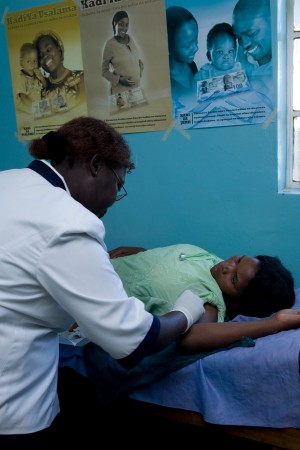Vouchers Are Putting Kenyan Women in Charge of Care
Editor’s Note: This post is one in an occasional series with the Center for Health Market Innovations about market-based approaches to improving health care delivery. Past articles may be found here. All photos by Richard Lord and courtesy of the Population Coucil.
Nearly 15,000 women die each year in Kenya due to pregnancy-related complications and an additional 200,000, conservatively, suffer from disabilities caused by complications. A collaborative effort of the Kenyan government, German development bank (KfW), and PriceWaterhouseCoopers aims to reduce these staggering numbers. In 2005, the partners launched a program that offers vouchers or coupons to stimulate demand from consumers to seek care for pregnancies and to reimburse high-quality healthcare suppliers for providing the contracted services. (It will be expanded to a new district, Kilifi, later this week).
Unlike other output-based voucher programs, this program works with both private and public sector facilities allowing for greater competition and better service coverage. Ben Bellows, an associate at the Population Council in Nairobi, is studying how the Kenya Reproductive Health Output-Based Aid (OBA) Voucher Program and similar initiatives in East Africa and south Asia work, and how they can be designed to promote long-term efficiency and viability.

Rose Reis: Why set up this program?
Ben Bellows (pictured left): Current programs for prenatal care and deliveries are not reaching the women who need the services the most. In Kenya, DHS data tells us that 56 percent of women deliver outside of a facility. If a woman experiences a complication far from proper medical care she risks losing her life.
Reis: What is the concept behind selling coupons to women who may become pregnant?
Bellows: Demand side financing is an economic tool to stimulate consumer interest in health care services. In Kenya and Uganda, consumers purchase vouchers from distributors in their neighborhood at very low costs. The safe motherhood voucher costs clients Ksh 200 and UgSh 3000 (approximately US$2.30 and US$1.40) and the family planning voucher is Ksh 100 (US$1.35) and UgSh 3,000 (US$1.40), while service providers are reimbursed up to a maximum of Ksh 20,000 (US$235) for complicated deliveries.
Reis: What effect do vouchers have on behavior?
Bellows: Lower income people, often lacking access to decent facilities, learn to demand high quality services. Young expectant mothers can feel empowered. The vouchers also change provider-patient interaction in areas where disrespect and abuse are serious problems. You hear time and time again that university-educated medical staff are disrespectful to uneducated patients at facilities. The thing is, poor women sometimes leave without paying (“escapees” is what I’ve heard them called). With the vouchers, these patients now are seen as a revenue source and are better treated.
Reis: Have you personally seen the impact of the vouchers on local women?
Bellows: Last March in a rural village of western Uganda I met a woman (who) paid for a previous delivery at a faith-based hospital for 20,000 UgSh-she sold part of her harvest to pay for it and her husband worked overtime. This time she bought a voucher from a local pastor after hearing from a neighbor, who used vouchers after a previous c-section forced her to sell her land to pay for the 90,000 UgSh (about $40 USD) operation.
Reis: What are some of the weaknesses of the system?
Bellows: Many people find ways to game systems, and vouchers are no exception. To monitor for fraud, as any good retailer would do, the Voucher Management Agency, PriceWaterhouseCoopers in Kenya, does actuary accounting for each coupon issued. They look for irregularities like serially-numbered claims occurring together: The provider may have purchased a series of vouchers from the distributor directly with a bribe or women might sell them directly to providers.
A big challenge in results-based financing is determining eligibility. PWC uses a poverty-grading tool. Markers for poverty included housing, medical access, water source, rent, sanitation, income, and number of meals taken per day.
Future expansion is a question. The management process – including the verification process and claims processing – works fine with 10,000 patients. What part of system breaks when you increase it tenfold? Additional research to find efficiency gains can improve the system’s political sustainability and impact on public health at a larger scale.

In some government-run voucher programs, public facilities are allowed to join the program by default (an “opt-out” approach). In Kenya or Uganda, in contrast, voucher programs have screening rounds to qualify facilities that want to join (a rigid “opt-in” strategy). Administrators visit facilities several times to grade infrastructure and staff capabilities. Some facilities qualify and some don’t. In Uganda, facilities participating are all private, and in Kenya there are public and private facilities.
Reis: How do you control the quality of facilities participating?
Bellows: In randomly sampled facilities, you observe provider-client observations client. You conduct exit interviews. You offer incentives for reporting poor quality, send surprise inspectors or ghost clients.
The challenge is as programs grow, how do you carry out quality assurance at larger numbers of facilities? After the baseline accreditation process, routine quality assurance programs are needed. In Kenya, PWC conducts exit interviews with a rolling sample of patients and assesses facility infrastructure on an annual basis.
Reis: You study a concept called demand-side financing for social franchising. This sounds technical, can you explain?
Bellows: Franchising is a way to standardize supply-this may be too simplistic, but you standardize your supply of contraceptive services similar to how you can standardize hamburgers. But in health, it doesn’t consistently increase consumer demand from low-income groups. If you change the quality of the facility, in many cases, people still go to nearby facilities.
Vouchers change the landscape, making it financially feasible to travel further. If you reduce cost at facility patients can use out of pocket money for transport.
Price works as an effect modifier on distance. The distance you can travel for health care is modified by available money you have to spend on it. So vouchers modify distance people are willing to travel for care.
Who typically runs health franchises and what services do they provide?
Bellows: Mostly NGOs although for-profit enterprises also engage in health franchises. With a few exceptions, like Greenstar in Pakistan, franchises do not make up a major part of national service delivery markets. This may change as large payers invest in networks and cover more patients with access to franchises. Government could purchase from different networks which would compete in pricing and quality at multiple facilities.
Brands tend to signal a discrete service delivery package, like family planning, but there are opportunities for franchised primary health care clinics to provide a broad range of care – like World Health Partners in India, with (clinics0 out into the hinterlands.
Reis: What franchises include demand-side financing schemes?
Bellows: There are just a handful of examples. In Madagascar, vouchers account for 75 percent of ProFemina’s payment sources and 25 percent of Top Réseau’s. Vouchers also account for 50 percent of payments for BlueStar Sierra Leone. These programs started only in the past year to stimulate more volume in existing facilities. Whether they translate into better health for populations remains to be seen.
Please like NextBillion on Facebook and follow us on Twitter.
- Categories
- Uncategorized
